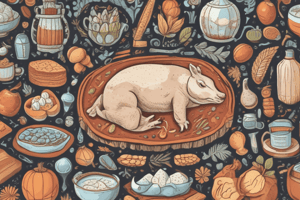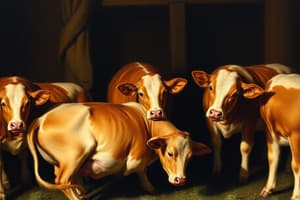Podcast
Questions and Answers
What are the two primary types of carbohydrates found in animal feeds?
What are the two primary types of carbohydrates found in animal feeds?
The two primary types are starch and fiber.
What role does lignin play in animal nutrition?
What role does lignin play in animal nutrition?
Lignin is completely indigestible and reduces the digestibility of other dietary components.
Describe the structure of triglycerides.
Describe the structure of triglycerides.
Triglycerides are composed of a glycerol backbone and three fatty acids.
What are essential amino acids, and can you name two?
What are essential amino acids, and can you name two?
What is the primary function of lipase in fat digestion?
What is the primary function of lipase in fat digestion?
What happens to excess ammonia produced during protein metabolism?
What happens to excess ammonia produced during protein metabolism?
What is digestible energy (DE) in the context of feed energy?
What is digestible energy (DE) in the context of feed energy?
What is the significance of whole grain cereals in animal feeds?
What is the significance of whole grain cereals in animal feeds?
What impact does lignin have on the digestibility of other dietary components?
What impact does lignin have on the digestibility of other dietary components?
How do simple and mixed triglycerides differ in composition?
How do simple and mixed triglycerides differ in composition?
What is the consequence of excess ammonia produced from protein metabolism in animals?
What is the consequence of excess ammonia produced from protein metabolism in animals?
Describe the role of bile in fat digestion.
Describe the role of bile in fat digestion.
What is the significance of the partitioning of feed energy in ruminants?
What is the significance of the partitioning of feed energy in ruminants?
Explain the importance of starch found in whole grain cereals for animal diets.
Explain the importance of starch found in whole grain cereals for animal diets.
How are essential and non-essential amino acids differentiated in animal nutrition?
How are essential and non-essential amino acids differentiated in animal nutrition?
What is digestible energy (DE) and how is it relevant in animal feeding practices?
What is digestible energy (DE) and how is it relevant in animal feeding practices?
What is a primary role of fat in animal diets?
What is a primary role of fat in animal diets?
Which component primarily reduces the digestibility of other dietary components?
Which component primarily reduces the digestibility of other dietary components?
What type of triglyceride consists of three identical fatty acids?
What type of triglyceride consists of three identical fatty acids?
What is the primary function of bile in the digestion of fats?
What is the primary function of bile in the digestion of fats?
Which amino acid is classified as essential?
Which amino acid is classified as essential?
What primarily occurs to protein in the ruminant diet?
What primarily occurs to protein in the ruminant diet?
Which component of feeds and forages contains substantial quantities of starch?
Which component of feeds and forages contains substantial quantities of starch?
What is the main purpose of measuring digestible energy (DE) in animal feeds?
What is the main purpose of measuring digestible energy (DE) in animal feeds?
Flashcards are hidden until you start studying
Study Notes
Components of Feeds and Forages
- Important to understand the basic nutritional components provided by feeds and forages.
Carbohydrates (CHO)
- Classified into simple and complex forms.
- Lignin is indigestible, negatively impacting the digestibility of fiber and protein.
- Whole grain cereals are rich in starch, particularly amylose and amylopectin contained in the endosperm.
Energy, Protein, and Fibre
- Grass, barley, and cottonseed meal are significant sources of energy and protein.
- Protein in the diet primarily consists of amino acids.
Fat and Energy in the Diet
- Fat is predominantly found as triglycerides, composed of glycerol and three fatty acids.
- Simple triglycerides contain identical fatty acids, while mixed triglycerides contain different fatty acids.
- Functions of fat in the diet include providing energy, aiding in nutrient absorption, and supporting cellular structures.
Digestion of Fat
- Fat globules are initially hard to digest, requiring them to move directly from the stomach to the small intestine.
- Pancreatic lipase breaks down fatty acids; bile facilitates the enzyme's action by emulsifying fats.
Protein
- Proteins are chains of amino acids; they are essential for various bodily functions.
- Essential amino acids must be consumed through the diet, while non-essential amino acids can be synthesized by the body.
- Excess protein is broken down into ammonia, which is converted to urea for excretion.
Metabolism and Measurement of Energy in Ruminants
- Digestible Energy (DE) is the portion of energy from feed that is absorbed and not lost in feces.
- Understanding feed energy partitioning is crucial for assessing nutritional efficiency in ruminants.
Components of Feeds and Forages
- Important to understand the basic nutritional components provided by feeds and forages.
Carbohydrates (CHO)
- Classified into simple and complex forms.
- Lignin is indigestible, negatively impacting the digestibility of fiber and protein.
- Whole grain cereals are rich in starch, particularly amylose and amylopectin contained in the endosperm.
Energy, Protein, and Fibre
- Grass, barley, and cottonseed meal are significant sources of energy and protein.
- Protein in the diet primarily consists of amino acids.
Fat and Energy in the Diet
- Fat is predominantly found as triglycerides, composed of glycerol and three fatty acids.
- Simple triglycerides contain identical fatty acids, while mixed triglycerides contain different fatty acids.
- Functions of fat in the diet include providing energy, aiding in nutrient absorption, and supporting cellular structures.
Digestion of Fat
- Fat globules are initially hard to digest, requiring them to move directly from the stomach to the small intestine.
- Pancreatic lipase breaks down fatty acids; bile facilitates the enzyme's action by emulsifying fats.
Protein
- Proteins are chains of amino acids; they are essential for various bodily functions.
- Essential amino acids must be consumed through the diet, while non-essential amino acids can be synthesized by the body.
- Excess protein is broken down into ammonia, which is converted to urea for excretion.
Metabolism and Measurement of Energy in Ruminants
- Digestible Energy (DE) is the portion of energy from feed that is absorbed and not lost in feces.
- Understanding feed energy partitioning is crucial for assessing nutritional efficiency in ruminants.
Animal Nutrition
- Feeds and forages are essential components for animal diets and include various nutrients necessary for growth and development.
Carbohydrates (CHO)
- Carbohydrates are primary energy sources for animals, classified as simple or complex sugars.
- Lignin is indigestible, negatively affecting the digestibility of fiber and protein.
- Whole grain cereals, such as barley, are rich in starch, primarily in the forms of amylose and amylopectin, which are located in the endosperm.
Energy, Protein, and Fibre Sources
- Energy sources include grains and fats, which provide high-caloric diets necessary for growth and maintenance.
- Protein sources in livestock diets include grass and cottonseed meal, providing essential amino acids.
- Fibre supports digestive health and gut function in animals.
Fat and Energy in the Diet
- Fats, primarily triglycerides, are composed of glycerol and three fatty acids, serving as a concentrated energy source.
- Simple triglycerides contain identical fatty acids, whereas mixed triglycerides consist of different fatty acids.
- Dietary fat aids in the absorption of fat-soluble vitamins and provides essential fatty acids.
Digestion of Fat
- Fat globules are challenging to digest in the stomach, requiring movement to the small intestines for further breakdown.
- Pancreatic lipase, activated by bile, facilitates the emulsification and breakdown of fats into fatty acids.
Protein Structure and Function
- Proteins are made from amino acids, which can be categorized into essential and non-essential groups.
- Essential amino acids include arginine and histidine; non-essential amino acids include alanine and glycine.
- Amino acids are broken down into ammonia, which is converted to urea for excretion when in excess.
Metabolism and Measurement of Energy in Ruminants
- Digestible Energy (DE) refers to the fraction of feed energy that is absorbed and utilized by the body, excluding energy lost in feces.
- Understanding the partitioning of feed energy helps optimize ruminant diets for efficient nutrient utilization.
Studying That Suits You
Use AI to generate personalized quizzes and flashcards to suit your learning preferences.




